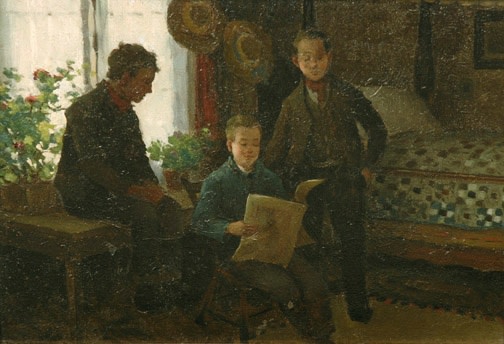An Appreciation of Suzor-Coté's Genre Painting ''Adolescent Reading'' (1896)
When Suzor-Coté returned to Arthabaska in June of 1894 after three years of art study in Paris it was clear that he was doing so as an artist truly accomplished in his field. In fact it is noteworthy that he was honoured with the acceptance of work to exhibit at the Salon de la société des artistes français, an important annual juried exhibition. Certainly one of the finest Suzor-Coté paintings of 1894 that we have sold, Still Life with Lilies, will attest to his level of mastery at the date.

Marc-Aurèle Suzor-Coté, Adolescent Reading, 1896
Oil on panel, 10 x 14 in
In Suzor-Coté: light and matter, published to accompany the Suzor-Coté Exhibition for the National Gallery of Canada and the Musée National des Beaux-arts du Quebec in 2003, curator Professor Laurier Lacroix writes that Suzor-Coté opened a studio on the upper floor of a YMCA located at Dominion Square, a studio where he could paint, exhibit his work and "court art lovers more effectively" (pg. 74). Then, in September and October, 1895, he built a second studio behind the family house in Arthabaska, which was described in the Union des Cantons de l’Est to be "like a real state of the art French studio in every respect."
According to Professor Lacroix, when the studio opened the periodical Union des Cantons de l’Est became the artist’s spokesperson by inviting "‘all friends to drop by for a little visit’" (Suzor-Coté: light and matter, 2003, pg. 74). Like the Montreal studio, Suzor-Coté used the Arthabaska studio as a painting place, an exhibition space and a place to invite friends and potential patrons. He spent the summer of 1896 in Arthabaska where he undoubtedly painted our composition Rangée des peupliers après un gros vent (Row of Poplars after a Great Wind). Not coincidentally, this area, now considered part of the town of Victoriaville, Quebec, is often referred to as the bois franc (hardwood) region, a reference to the abundance of hardwood trees which includes, of course, the majestic poplars featured in our painting.
Prime Minister Wilfred Laurier, the newly elected Prime Minister of Canada, a native of Arthabaska himself, is recorded to have visited Suzor-Coté at least once before the end of October in 1896. The untitled Suzor-Coté representing what appeared to be either three young men or perhaps three adolescents reading in an interior must be considered among his finest genre paintings of that generation. Whereas its roots may be in his well documented My Room of 1892 perhaps painted in Cernay, France, this painting, Adolescents Reading of 1896 demonstrates the magnificence of Still Life with Lilies of 1894. With the interest in local subject matter we see in the 1895 canvas The Sick Child, which we sold to the Musée du Québec a few decades ago, in Adolescents Reading, Suzor-Coté exhibits a habit he subsequently developed at this particular stage of his career, that of preparing "the ground of his paintings by applying the paint not in a smooth and uniform manner, but thickly and with a underlying energy which gave great energy to the surface colours" (Laurier Lacroix, Suzor-Coté: light and matter, 2003, pg. 86).
A critical eye in appreciation of this painting will likely concur that the work we have chosen to call Adolescents Reading is a triumph of this generation of Suzor-Coté’s oeuvre and portages some of the great genre paintings which he was to create in France a few years later, such as Le vieux renter (The Old Pensioner) and Entre voisin, paysans normands (Between Neighbours, Normand Peasants). Suzor-Coté returned to France in the fall of 1897 where he stayed for the greater part of the next ten years. Professor Lacroix’s exhaustive research allowed him to document in a piecemeal fashion the numerous areas and regions Suzor-Coté painted throughout this decade as well as the abundance of exhibitions and salons where his paintings were included.
The inclusion of ten of the artist’s paintings in the Canada Pavilion at the 1900 Paris World’s Fair, where he earned a bronze medal, represented "a professional turning point for the artist" (Laurier Lacroix, Suzor-Coté: light and matter, 2003, pg. 101). Proudly, I refer you to our especially fine canvas titled by the artist on the reverse Les peupliers de la ferme Baron (The Poplars on Baron's Farm), dated 1900 on the front, and painted on a French canvas with French stretchers. I have no hesitation in suggesting it not frightfully dissimilar to the painting "Moonrise" of circa 1901 included in the National Gallery and Quebec City Suzor-Coté Exhibition of 2003. The End of the Day and Twilight; although impossible to say with absolute certainty the location described in these two accomplished atmospheric studies, The End of the Dayshows strong references to sketches previously identified as of the period around 1907 (perhaps even a year or two later).
I won’t pretend to be an authority on fences but only because I do think the information may be reliable I am pleased to relate that some who have admired this work that have been categorical in their claim that the type of fencing in the fields identify this as a Quebec subject. As for the painting we have elected to call Twilight, which is actually without a title in the artist’s hand, in our opinion, it is adequately close in both composition and style to the painting Twilight, 1907. that was included in the Ottawa and Quebec City 2003 Suzor-Coté Exhibition and must literally be a sister painting (see catalogue painting no. 53). Professor Lacroix's description of the work - that it "evokes the heavy and somber atmosphere of the day’s end under a hazy sun" (Suzor-Coté: light and matter, 2003, pg. 170) - could be equally and appropriately applied to our Twilight.





Add a comment